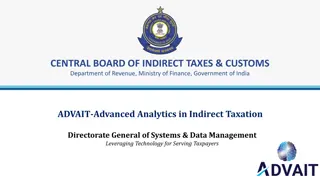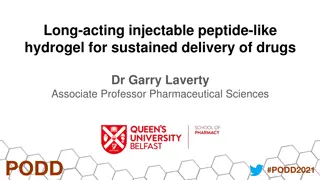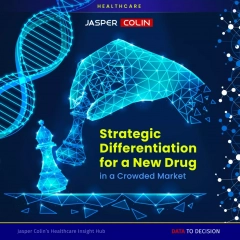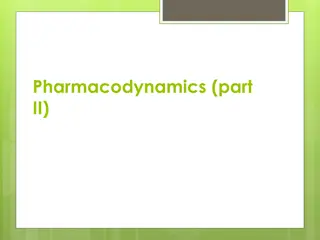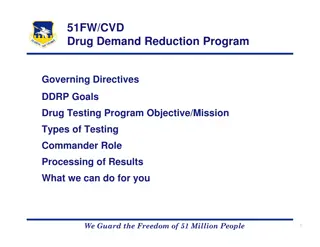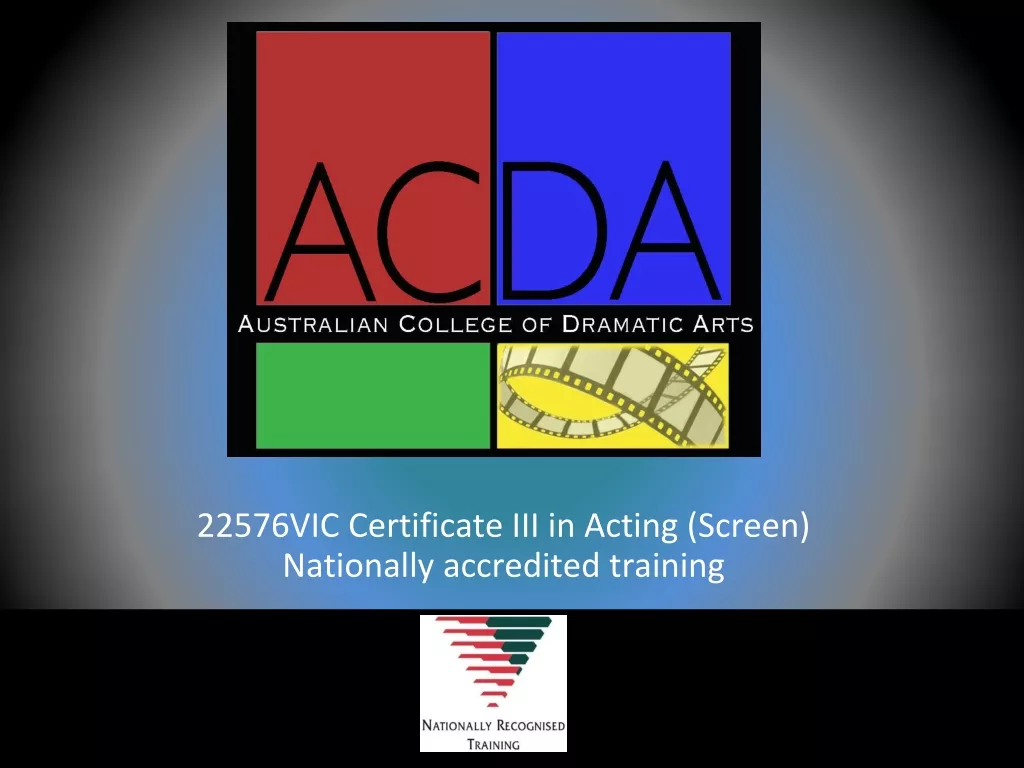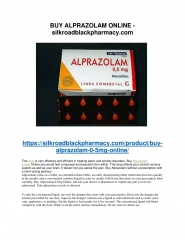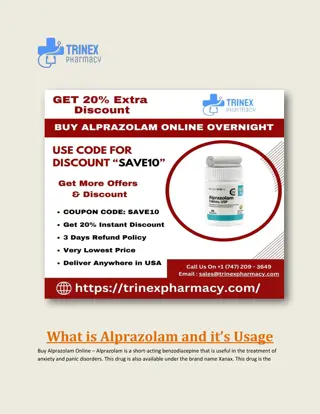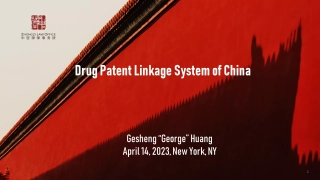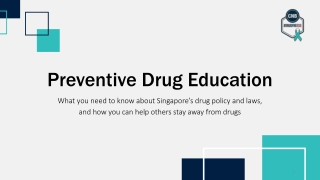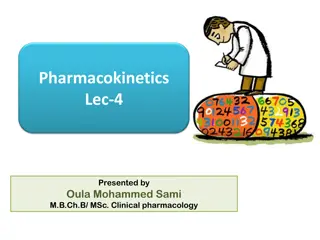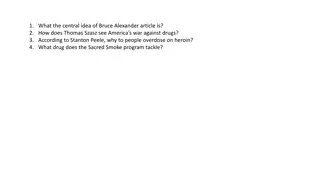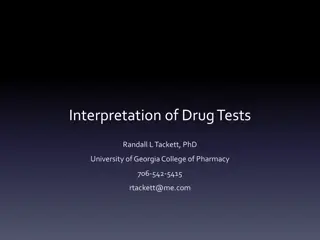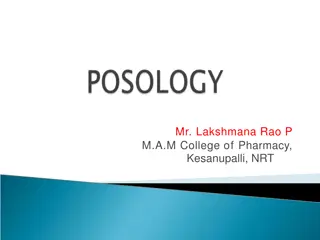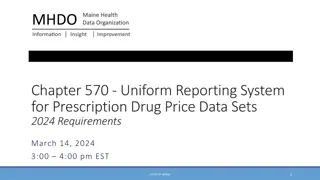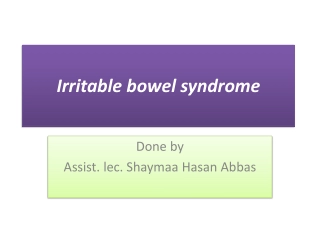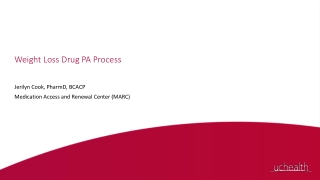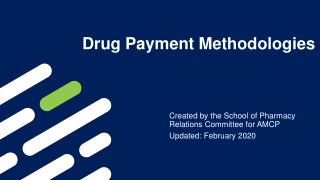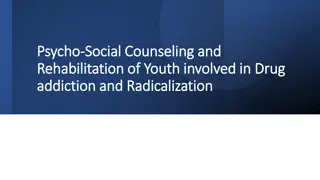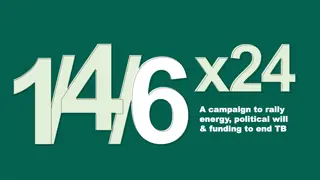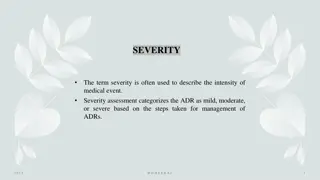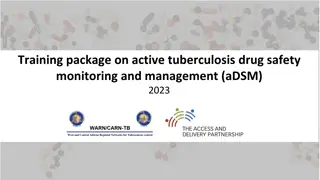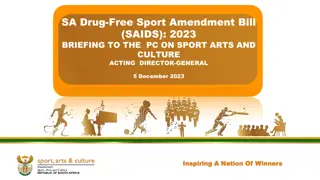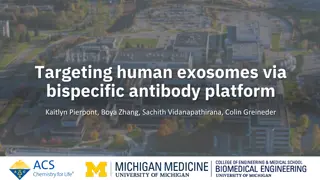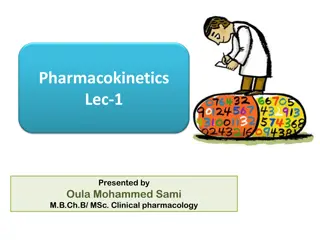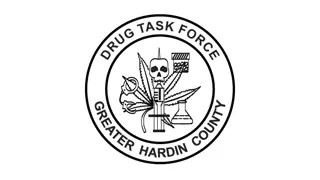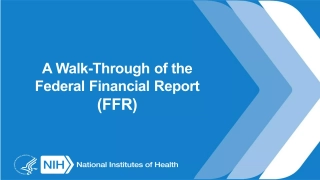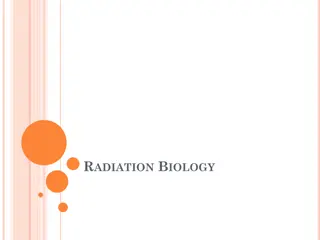Indirect-Acting Cholinergic Drug
Explore the classification, mechanism of action, and pharmacological effects of indirect-acting cholinergic drugs such as anticholinesterases. Learn about the importance, main uses, adverse effects, and contraindications of these drugs. Discover how anticholinesterases increase acetylcholine concentrations to impact cholinergic receptors and the CNS.
Indirect-Acting Cholinergic Drug
PowerPoint presentation about 'Indirect-Acting Cholinergic Drug'. This presentation describes the topic on Explore the classification, mechanism of action, and pharmacological effects of indirect-acting cholinergic drugs such as anticholinesterases. Learn about the importance, main uses, adverse effects, and contraindications of these drugs. Discover how anticholinesterases increase acetylcholine concentrations to impact cholinergic receptors and the CNS.. Download this presentation absolutely free.
Presentation Transcript
Indirect-Acting Cholinergic Drug Important Main text Male slide Female slide Extra info Doctor notes EDITING FILE
OBJECTIVES Classification of indirect acting cholinomimetics Mechanism of action, kinetics, dynamics and uses of Anticholinesterases Adverse effects & contraindications of anticholinesterases Symptoms and treatment of organophosphates toxicity Click for useful video!!
Indirect cholinomimetics (anticholinesterases): Mechanism of action: Anticholinesterases prevent hydrolysis of Ach by inhibiting acetyl cholinesterase thus increase Ach concentrations and actions at the cholinergic receptors (both nicotinic and muscarinic). (unlike direct cholinomimetics) You must know 1-drug name 2-which receptor (muscarinic or nicotinic or both) 3-if its direct or indirect-reversible\Irreversible- 4-the action site + if it can act on cns or not
Indirect cholinomimetics (anticholinesterases): Anticholinesterases are similar in structure to Ach so combine with cholinesterase enzyme (two sites, anionic and esteratic sites) instead of Ach. Note that edrophonium has one site (anionic site) that binds with the Ach-esterase unlike neostigmine which has both anionic and esteratic sites this makes neostigmine bind to Ach-esterase longer giving it a longer duration of action than edrophonium. just to understand Acetylcholine Neostigmine Edrophonium
Classification of anticholinestrase for each drug you must know the entire name Eg: Neostigmine is 1-Reversible 2- Anticholinesterase 3-Carbamate esters Reversible Irreversible Short acting (Alcohol) Intermediate acting (carbamate esters) Very long acting (Phosphate esters) e.g insecticides,gas war -Physostigmine -Pyridostigmine -Neostigmine -edrophonium Example: -Ecothiophate -Isoflurophate Example: It is alcohol,forms weak hydrogen bond with acetylcholinesterase enzyme (has only one site: anionic site) binds to two sites of cholinesterase enzyme form very stable covalent bond with cholinesterase Binding with Ach- esterase Binding with Ach-esterase All phosphates are lipid soluble except ecothiophate which is polar. drugs such as edrophonium, it is an alcohol Features: All polar except physostigmine Features:
Site Action Pharmacological effects of anticholinesterases: *ALL Anticholinesterases have muscarinic and nicotinic actions (N & M actions) and some have CNS effects (only lipid soluble drugs). Neuromuscular junction -Therapeutic dose: muscle contraction. -Toxic dose: relaxation or paralysis of skeletal muscles. Ganglia Stimulation of sympathetic and parasympathetic ganglia Nicotinic actions release of catecholamines (Adrenal & Noradrenal). Adrenal medulla -Contraction of circular muscle of iris (miosis)(M3) -Contraction of ciliary muscles for near vision (M3) -Decrease in intraocular. Eye -Nicotinic actions. -Muscarinic actions: similar to Ach (miosis, bradycardia, bronchoconstriction, increased motility, secretion of exocrine glands). bradycardia ( heart rate ) (M2) Release of NO (EDRF) Heart endothelium Constriction of bronchial smooth muscles Increase bronchial secretion M3 Lung Muscarinic actions -Increased motility (peristalsis) -Increased secretion -Relaxation of sphincter M3 GIT -CNS actions: (excitation, convulsion, respiratory failure, coma). only for lipid soluble anticholinesterases e.g. physostigmine & phosphate ester (except ecothiophate that is polar). -Contraction of muscles -Relaxation of sphincter M3 Urinary Increase of sweat, saliva, lacrimal, bronchial, intestinal secretions M3 Exocrine glands
Indirect Cholinomimetics Binding with Ach esterases Chemical structure Drug Action P.K Uses Polar (alcohol) NOT absorbed orally (must be given by injection). short duration of Action: (5-15 mins) Reversible anticholinesterase attach mainly to acetyl cholinesterase by weak hydrogen bond. Muscarinic and nicotinic actions Used to diagnose myasthenia gravis Quaternary ammonium compound Edrophonium Glaucoma (M) Atropine toxicity (anticholinergic drug) from 439:(Atropine can cross BBB therefore we use Physostigmine which also can cross BBB to block the muscarinic receptor in the brain resulting in treating the toxicity) - - Non polar(lipid soluble). Good oral absorption Cross BBB (has CNS effects) Intermediate duration of action(0.5-2 hr) Reversible anticholinesterase Muscarinic and nicotinic actions Has CNS effect binds to two sites of cholinesterase enzyme(covalent bond) Tertiary ammonium compound Physostigmine binds to two sites of cholinesterase enzyme(covalent bond) Polar Muscarinic and nicotinic actions Quaternary ammonium compound Treatment of myasthenia gravis Pyridostigmine Intermediate duration of action (3-6 hr)
Binding with Ach esterases Chemical structure Drug Action P.K Uses -Treatment of myasthenia gravis(N) - Paralytic ileus & Urinary retention - Competitive neuromuscular blockers intoxication (curare toxicity). muscarinic and nicotinic actions(similar uses to bethanechol) prominent on GIT & urinary tract No CNS effect polar compound Intermediate duration of action (0.5-2hr) binds to two sites of cholinesterase enzyme (covalent bond) Quaternary ammonium compound Neostigmine Polar Quaternary ammonium compound Treatment of myasthenia gravis. muscarinic and nicotinic actions Long duration of action (4-8hr). Ambenonium _______ -Is a centrally acting reversible acetylcholinesterase inhibitor M4 , M5 Treatment of dementia of Alzheimer s disease Lipid soluble given orally Donepezil _______ _______
Indirect Cholinomimetics (Organophosphorous compounds) Ecothiophate Mechanism Irreversible anticholinesterase Binds to cholinesterase by strong covalent bond. Have very long duration of action Aging make bond extremely stable All are highly lipid soluble except ecothiophate Used for glaucoma. organo high lipid soluble
Symptoms of Organophosphate Toxicity CNS Muscles GIT Lungs -Convulsion Initial twitching of skeletal muscle leads to -weakness -paralysis -Increased GIT motility leading to cramps -sever bradycardia -coma Bronchospasm -hypotension -respiratory failure -Diarrhea salivation Sweating lacrimation Organo = lipid soluble can be absorbed via skin
Treatment of organophosphate toxicity Atropine Cholinesterase reactivators -oximes- Support respiration -To block Muscarinic actions And CNS effects- Pralidoxime (PAM) Cholinesterase reactivator or regenerator Acts by regeneration of cholinesterase enzyme Reactivates recently inhabited enzymes before aging Action I.V over 15-30 min for organophosphate intoxication Uses
Adverse effects & contraindication Of cholinergic drugs Adverse effects of cholinergic drugs Bradycardia Hypotension Bronchospasm Diarrhea Sweating & Salivation Bronchial asthma Peptic ulcer Angina pectoris Intestinal Obstruction Urinary incontinence Contraindic- ation of cholinergic drugs
Summary for cholinomimetics and their uses Eye : treatment of glaucoma 1-Pilocarpine (direct muscarinic agonist) 2-Physostigmine 3- Ecothiophate (indirect cholinomimetics) Urinary retention and paralytic lieus 1-Bethanechol (direct) 2-Neostigmine (indirect) Myasthenia gravis (Only indirect cholinomimetics) 1-Pyridostigmine 2- Neostigmine 3- Ambenonium Xerostomia 1-Pilocarpine 2-Cevimeline (Sjogren s syndrome) Alzheimer disease 1-Donepezil
MCQs: 1-Physostigmine is an example of ? D) I guess we will never know . A)Alcohols B)Carbamate esters C)Phosphate esters 2-Contraction of circular muscle of iris (miosis) what kind of action ? A)Nicotinic actions B)Muscarinic actions C) Both D) I don t know 3- Edrophonium is a drug used to ? A)diagnose myasthenia gravis C)Treatment of myasthenia gravis B)Glaucoma D)it is not a drug 4-what is the Symptoms of organophosphate toxicity on heart? A)bradycardia B)heart toxicity (: C)hypertension D)A and C 5- Alzheimer disease can be treated using which drug? A)Cevimeline B)Pyridostigmine C)Donepezil D)who says we can?!! 1)B 2)B 3)A 4)A 5)C
SAQ: 1- what is the Mechanism of action for Indirect cholinomimetics? Your patient if you didn t learn how to spell the drug name 2-if your patient is taking atracurium drug but after a while he had curare toxicity what would you give him? And why? 3-list the Adverse effects of cholinergic drugs 4-If your patient had an atropine overdose-toxicity- how would you treat him ?why?from the Dr 5-if you are in emergency and a patient came with a muscle paralysis how would you know which drug causes his paralysis? from the Dr Hint either cholinergic or skeletal muscle relaxant toxicity 4-By giving him Physostigmine Because it is anticholinergic and lipid soluble so can act centrally and affect parasympathetic 5-We can give him edrophonium if he gets better then it is toxicity via skeletal muscle relaxant Answers 1-Anticholinesterases prevent hydrolysis of Ach by inhibiting acetylcholinesterase thus increase Ach concentrations and actions at the cholinergic receptors (both nicotinic and muscarinic). 2-Neostigmine because it is intoxication 3-Bradycardia - Bronchospasm - Diarrhea - Sweating & Salivation
THE LEADER OF PHARMACOLOGY AND MEMBERS Saif alotaibi Mayssam Aljaloud Reema Alhussein Rahaf Almotairi Layan Aldoukhi Farah Alfayez Reema Alquraini Alhnouf Alyami Alhatoun Alhawyan Refal Alamry Razan Almanjomi Shatha Alshabani Sara Alsuwaidan Mohammad Al Rashed Saud Al Taleb Azzam alotaibi Nawaf alotaibi Mohammed aloraini Talal alharbi Contact us: pharmacology442@gmail.com


